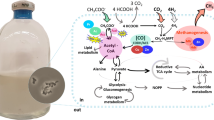Abstract
The effect of different mineral nutrients on the kinetics of methane biodegradation by a mixed culture of methanotrophic bacteria was studied. The substrate factors examined were ammonia, iron, copper, manganese, phosphate, and sulphide. The presence of iron in the growth medium had a strong effect on the yield coefficient. Yield coefficients up to 0.49 mg protein per mg methane were observed when iron was added at concentrations of 0.10–5.0 mg/l. Iron addition also increased the maximum methane utilization rate. The same effect was observed after addition of ammonium to a medium where nitrate was the only nitrogen source. The observed Monod constant for methane utilization increased with increasing concentration of ammonia. This shows that ammonia is a weak competitive inhibitor as observed by other researchers. Relatively high levels of both ammonia (70 mg/l) and copper (300 µg/l) inhibited the methane degradation, probably due to the toxic effect of copper-amine complexes.
Similar content being viewed by others
References
Alvarez-Cohen L & McCarty P (1991) A cometabolic biotransformation model for halogenated aliphatic compounds exhibiting product toxicity. Environ. Sci. Technol. 25: 1381–1387
Arvin E (1991) Biodegradation kinetics of chlorinated aliphatics with methane oxidizing bacteria in an aerobic fixed biofilm reactor. Wat. Res. 25: 873–881
Bradford MM (1976) A rapid and sensitive method for the quantitation of microgram quantities of protein utilizing the principle of protein-dye binding. Anal. Biochem 72: 248–254
Broholm K, Christensen TH & Jensen BK (1992) Modelling TCE degradation by a mixed culture of methane-oxidizing bacteria. Wat. Res. 26: 1177–1185
Broholm K, Jensen BK, Christensen TH & Olsen L (1990) Toxicity of 1,1,1-trichloroethane and trichloroethene on a mixed culture of methane oxidizing bacteria. Appl. Environ. Microbiol. 56: 2488–2493
Carlsen, HN, Jørgensen L & Degn H (1991) Inhibition by ammonia of methane utilization inMethylococcus capsulatus (Bath). Appl. Microbiol. Biotechnol. 35: 124–127
Ferenci, T, Strøm T & Quayle JR (1975) Oxidation of carbon monoxide and methane byPseudomonas methanica. J. Gen. Microbiol. 91: 79–91
Fogel MM, Taddero AR & Fogel S (1986) Biodegradation of chlorinated ethenes by a methane-utilizing mixed culture. Appl. Environ. Microbiol. 51: 720–724
Fox GB, Froland AW, Dege EJ & Lipscomb DJ (1989) Purification and properties of a three-component system with high specific activity from a type II methanotroph. J. Biol. Chem. 264: 10023–10033
Henry S & Grbic-Galic D (1990) Effect of mineral media on trichloroethylene oxidation by aquifer methanotrophs. Microb. Ecology. 20: 151–169
Henson JM, Yates MV & Cochran JW (1989) Metabolism of chlorinated methanes, ethanes, and ethylenes by a mixed bacterial culture growing on methane. J. Ind. Microbiol. 4: 29–36
Henson JM, Yates MV, Cochran JW & Shackleford DL (1988) Microbial removal of halogenated methanes, ethanes, and ethylenes in an aerobic soil exposed to methane. FEMS Microbiol. Ecol. 53: 193–201
Hicks CR (1982) Fundamental concepts in the design of experiments, 3th edn, Holt, Reinhart & Winson, New York
Jørgensen L & Degn H (1983) Mass spectrometric measurements of methane and oxygen utilization by methanotrophic bacteria. Microbiol. Lett. 20: 331–335
—— (1987) Growth rate and methane affinity of a turbidostatic and oxystatic continuous culture ofMethylococcus capsulatus (Bath). Biotechnol. Lett. 9: 71–76
Leak DJ & Dalton H (1986) Growth yields of methanotrophs. 1. Effect of copper on the energetics of methane oxidation. Appl. Microbiol. Biotechnol. 23: 470–476
Linton JD & Vokes J (1978) Growth of methane utilising bacteriumMethylococcus NCIB 11083 in mineral salts medium with methanol as the sole source of carbon. Microbiol. Lett. 4: 125–128
Oldenhuis R, Vink RLJM, Janssen DB & Witholt B (1989) Degradation of chlorinated aliphatic hydrocarbons byMethylosinus trichosporium OB3b expressing soluble methane mono-oxygenase. Appl. Environ. Microbiol. 55: 2819–2826
O'Neill GJ & Wilkinson FJ (1977) Oxidation of ammonia by methane-oxidizing bacterium and the effects of ammonia on methane oxidation. J. Gen. Microbiol. 100: 407–412
Prior SD & Dalton H (1985) The effect of copper ions on membrane content and methane mono-oxygenase activity in methanol-grown cells ofMethylococcus capsulatus (Bath). J. Gen. Microbiol. 131: 155–163
SAS (1985) Version 6, release 6,02, SAS Institute, Inc., Cary, N.C.
Sato C, Leung SW & Schnoor JL (1988) Toxic response ofNitrosomonas europaca to copper in inorganic medium and waste-water. Wat. Res. 22: 1117–1127
Stainer, RY, Ingraham JL, Wheelis ML & Paisto PR (1989) General Microbiology, 5th edn, MacMillan Education Ltd, London
Tsien HC, Brusseau GA, Hanson RS & Wackett LP (1989) Biodegradation of trichlorothylene byMethylosinus trichosporium OB3b. Appl. Environ. Microbiol. 55: 3155–3161
Whittenbury R, Phillips KC & Wilkinson JF (1970) Enrichment, isolation, and some properties of methane-utilizing bacteria. J. Gen. Microbiol. 25: 225–233
Wilson JT & Wilson BH (1985) Biotransformation of trichloroethylene in soil. Appl. Environ. Microbiol. 49: 242–243
Author information
Authors and Affiliations
Rights and permissions
About this article
Cite this article
Boiesen, A., Arvin, E. & Broholm, K. Effect of mineral nutrients on the kinetics of methane utilization by methanotrophs. Biodegradation 4, 163–170 (1993). https://doi.org/10.1007/BF00695118
Received:
Accepted:
Issue Date:
DOI: https://doi.org/10.1007/BF00695118




